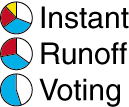
 Cal IRV FAQ
Cal IRV FAQ |
 Cal IRV FAQ
Cal IRV FAQ |
The "comeback kid" effect is relatively rare, and it tends to favor candidates supported by political machines that can quickly raise cash for a runoff campaign. IRV makes makes campaigns cheaper overall, so that candidates don't need as much money in the first place. Runoff campaigns become fiercely negative, a fact that can deter new candidates. And turnout is higher in a single IRV election than in runoffs, so the IRV election result is a more legitimate and accurate measure of the will of the people.
Imagine that you are at a car auction, and you can only make one bid. If you hold out at $3000, you may get the car, but there is some risk that you will be walking home. On the other hand, if you offer $6000, you can be certain that you'll be driving home. Voting always involves a similar bargaining process between yourself and all other voters. Much of the bargaining is built into the system, including the bid amounts. With plurality voting, it's as if you can only make one bid. With IRV, you hold out on your bid if it is competitive, but you get your compromise bid if your first one is not. With a pairwise method, it's as if you announce both bids at the same time, so you almost always get the compromise bid. So the voting method you prefer depends on which built-in strategy you prefer.
The pairwise methods work like this: voters' ballot rankings are used to determine the outcome of all one-on-one races. The candidate who beats all other candidates is the winner. There are often circular ties (that is, A beats B, B beats C, and C beats A); these are broken by successively ignoring the weakest victory. There are several variations on this, so we refer to pairwise 'methods' in the plural.
Imagine this hypothetical election:
|
The difference is that with IRV, Reagan and Carter voters are taking a risk on Anderson voters' second choices (to those voters' knowledge, those second choices could have easily gone the other way, handing the election to Carter). A pairwise method would force a compromise, even if that compromise had very weak first-choice support. With IRV, only Anderson voters have to compromise.
At the cost of some distortion of one's expressed preferences, both methods allow for alternative strategies. With IRV, voters who prefer another candidate can always rank Anderson first if they accept this compromise; their vote would go to their favorite if Anderson is eliminated. Voters can still gamble in a pairwise election: if Reagan and Carter voters list only their first choice, they surrender their ability to compromise, and gamble on Anderson voters' second choices. However, such gambling is more dangerous than it is in IRV - if it turns out that their favorite candidate is weak, their votes are wasted and their last choice wins.
So if you prefer an election method that compels voters to compromise, you should prefer pairwise methods. If you prefer a method that makes you compromise when your candidate is weak, and lets you gamble on others' second-choice votes when your candidate is strong, you should prefer IRV.
If you do prefer pairwise methods, it's important to note that IRV has a lot more political momentum because it is similar to existing methods, and that implementation of IRV would create opportunities for pairwise and other methods, should they ever gain popular support. So, as a compromise, it would make sense to show support for IRV!
Pairwise voting methods are monotonic with respect to swapped pairs. This means that, on a ballot marked "Anderson,Reagan,Carter", if you swap Reagan and Carter so the ballot reads "Anderson,Carter,Reagan", the voting method ensures that Carter will not lose if he were already the winner, and Reagan will not win if he were a loser. IRV does not satisfy this, because this may cause Reagan to be eliminated, and the next choices of Reagan's voters could cause someone other than Carter to win.
IRV is monotonic with respect to added rankings. If you add a ranking to the end of the list on your ballot, or you add a ballot with a single ranking, it will always help that candidate win, and never hurt any higher-ranked candidates. Pairwise methods do not satisfy this, as demonstrated in a previous answer.
The fact that each of these voting methods satisfies one type of monotonicity and not the other is just another reflection of the tradeoff between compromising and gambling on a higher payoff that is inherent to all voting methods.